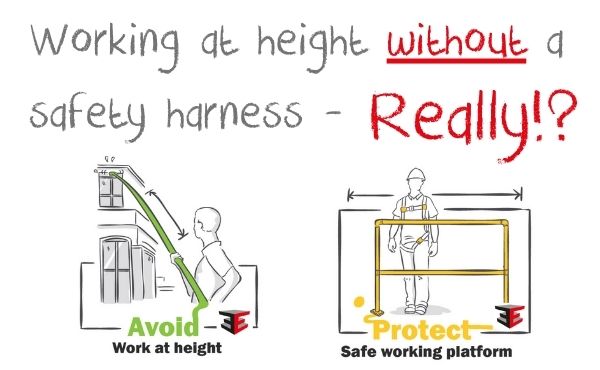Working at height without a safety harness
Working at height without a safety harness can’t be done right?
Well – it depends…
If the type of work your team are doing can avoid “working at height”, then YES!
YES – you are able to work at height without a safety harness.
What is working at height without a safety harness?
Basically, any “working at height” is where a member of the team could fall to a lower level and hurt themselves. This could be a fall
- into a hole in the ground (think inspection holes for confined space entry)
- through a fragile surface
- off an open edge
- down a slope
Avoid heights!
This is 100% the best way to not get hurt!
The best way to keep your team safe is to ensure everyone pays attention – they know to look where they are going, and they evaluate what they
are doing!
Think ahead at all times.
Consider if the task can be designed or managed differently to avoid working at height altogether?
Remote working
- definitely working at height without a safety harness!
Some tasks can be done at a safe distance – without exposing the team to height
- CCTV using drones
- long handled tools, some with cameras to perform a task
– including turning, moving, pushing, grabbing, cleaning by washing, blowing and even vacuuming!
Although it’s unlikely that you can clean the entire house from the comfort of your sofa. 😉
Is climbing a ladder - working at height?
[this is a whole new blog!!]

Source: Health and Safety Executive
Travelling
NO, using a ladder to access a different level is not working at height
Thought should be given
- to the angle of the ladder – vertical ladders are more tiring
- securing the ladder (tieing off)- if the climber needs a rest or needs to carry equipment transferring on and off the ladder is probably the most dangerous
Working
Thought should be given to the points raised for travelling…
Plus
• using a harness
• connected to a back up device (connector and lanyard)
• and secured to a suitable anchor point.
To catch you should your primary means of support (standing and holding on to the ladder) fail or slip
We can reduce the distance or consequences of a fall
- working near fragile surfaces (when these break – especially in roofs) – these are like holes in the floor
- being caught in nets – think the professional trapeze at the circus!
- landing on air bags – think the stunt people in “The Fall Guy” [am I showing my age?! 🤔]
- working near open edges – where there is no sufficient barrier to stop you falling off an edge
- temporary platforms such as crates, open scaffold or other platforms
- effectively fill the hole in so there is no longer an edge to fall over

[Not like the clowns at the circus!]
So - What is NOT Working at Height
- working near fragile surfaces (when these break – especially in roofs) – these are like holes in the floor
- being caught in nets – think the trapeze at the circus!
- landing on air bags – think the stunt people in “The Fall Guy” [am I showing my age?!]
- working near open edges – where there is no sufficient barrier to stop you falling off an edge
- temporary platforms such as crates, open scaffold or other platforms
- effectively fill the hole in so there is no longer an edge to fall over
So - should you be working at height without a safety harness?
Just because in certain circumstances it’s not needed
or even not required…
In my opinion its easier having a safety harness on and not needing it,
than needing a safety harness and not having it!
(Just think if you needed to be rescued – wearing a safety harness makes being rescued a whole lot easier!)
Do you have a rescue plan?
Need more?
– Follow me on LinkedIn for more advice
Want more in depth? Get the TIPS




